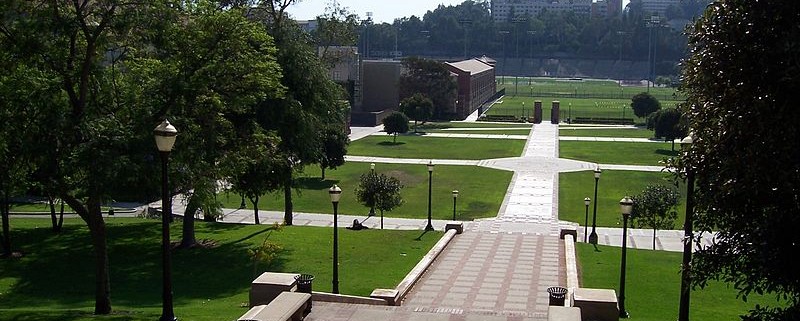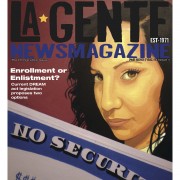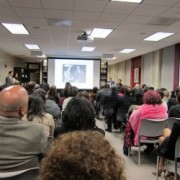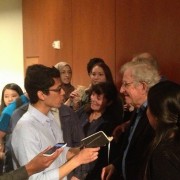‘How close to zero do they want us to get?’ Students of color under attack! We will not be silenced!
Photo by Neeta Lind
*Editor’s note:  This article was prepared by collaborator’s from these nine mother organizations who have chosen to voice their opinion in light of recent events.
This article was prepared by collaborator’s from these nine mother organizations who have chosen to voice their opinion in light of recent events.
This is a statement in response to the news article and opinion column that were published in the Daily Bruin on Tuesday, which aimed to undermine the integrity of the holistic admissions process at UCLA while also making the broader statement that certain communities of color do not deserve to be on this campus. As an immediate response, cultural organizations on campus attempted to cooperatively collaborate with the Daily Bruin by requesting a platform to showcase a student perspective outside of the views expressed by Daily Bruin staffers. However, in the process, we have been unfairly denied the opportunity to do so. As students to this University and as residents of this country, we all pay student fees, and respect freedom of speech and freedom of the press. As students we also have the right and duty to think critically. It is because of these issues that the journalistic integrity of the Daily Bruin should be called into question. On the corner of every opinion page of the Daily Bruin, it states that there is a policy “prohibiting the publication of articles that perpetuate derogatory cultural or ethnic stereotypes”. Thus, it is problematic that reckless language was used in the opinion piece. Claims that “minorities constitute an undue percentage of the freshman class”, and the suggestion for UCLA to “correct the iniquities” or immoral and grossly unfair behavior that the writer states “Sander seems to have uncovered”, are a complete violation, and as communities of color and allies, we are speaking out to say that we feel attacked and it is not OK! Thus, the following is our statement about the claims presented in the Daily Bruin:
The personal and academic contributions of underrepresented groups at UCLA, more specifically of Black/Afrikan and Chicana/o, Latina/o students, were attacked in two articles published by The Daily Bruin on October 23, 2012.
In the article, “Findings by law professor suggest that UCLA Admissions may be violating Prop 209,” the author notes that an unpublished report by Professor Sander suggests holistic admissions are unlawful. Further, Eitan Arom’s opinion piece, “Admissions disparity calls for review of system,” argues in favor of Sander’s report and demands for a new evaluation of the admissions process which is currently Holistic Review.
Both Sanders and Arom suggest that UCLA may be violating Proposition 209 through its utilization of the Holistic Admissions process. However, from an analytical standpoint, Sander’s argument is entirely flawed. First, Sander collected admissions data and comprised them into two groups: one group of admissions numbers between 2004 and 2006 before the holistic admissions process was implemented and another group of numbers between 2007 and 2009. Sander uses this data to assert that discrimination is occurring after the holistic scores are generated through the supplemental review application. The number of Black and Latina/o students increased, not because race was included, but because Holistic Admissions guaranteed that all students would receive a more personalized analysis in the process. Under the previous Comprehensive Review, readers would judge standardized scores separately from personal achievements; under the Holistic process academic achievement is reviewed in light of opportunities. Nonetheless, Sander’ analysis also does not include admissions data from recent years (2010-2012), which is necessary to analyze the long-term, current, and ongoing effects of UCLA’s holistic admissions policy.
Sander’s statement that admission officials “seem to be making discriminatory decisions with lots of black and Hispanic students with poor holistic scores being admitted” is extremely troubling. As a public institution, the University of California has a responsibility to educate the residents of this state. According to Professor Sander “lots of black and Hispanic students” are being admitted, yet he fails to recognize that although the students of color are applying to UCLA in significant numbers, the number of admitted students of color has remained more or less constant for the past years. According to official 2012 admissions data, 201 of 4,000 entering students from CA were Black, 1,011 Latino/a, 1,900 Asian and 1,330 white or Caucasian.
Particularly analyzing admit rates between 2007 and 2009, according to the University of California stat finder (UCOP), the overall admit rate of African-Americans applicants has decreased from 16.5 percent to 15.1 percent. Both Sander and Arom conveniently downplay the principal findings of the Mare study, an independent report examining UCLA’s implementation of holistic review, which explicitly states that “Mare’s report found no evidence of bias in UCLA’s admissions process [and that] academic merit holds the highest weight in an applicants review process”.
Students are placed on supplemental review usually because their academic achievements may have been curtailed due to personal unavoidable circumstances or if they have expressed an extraordinary talent in their application. The University allows these students the opportunity to further explain their situation and how they have grown from it. If students choose to return the additional information, readers are given a clearer picture of the student’s ability to succeed at UCLA.
Both Sander and Arom argue that the supplemental review process is “simply a smokescreen behind which race preferences can go unobstructed.” But as Associate Vice Chancellor Youlanda Copeland-Morgan has stated, the fundamental issue is that underrepresented students are more likely to face social and economic difficulties that would require further review. Sander and Arom may nitpick the fact that more students of color are admitted through the supplemental review process, but this policy is used by countless other prestigious Universities. Other institutions understand that students are individuals with struggles and ambitions, not just a standardized number.
In addition, the discourse Sander uses is an attempt to pit Asian students against Black and Latino/a students. By placing them on the same side as Whites, Sanders tries to argue that Holistic Admissions negatively affects Asian students’ access to UCLA. The author notes, “According to Sander’s analysis, there is a much higher percentage of black and Hispanic students who are offered admissions than Caucasian and Asian students among students who are assigned the same ‘mid-range’ holistic score.” Since Sander has not made his official report available, we are unsure if he categorizes all Asian-American Pacific Islander applicants within the same category, or if he looks at each ethnic/cultural background differently. The AAPI community in the United States is the most diverse racial group in regards to socioeconomic status and educational attainment. Contrary to Sander’s feckless arguments, Holistic Admissions helps underserved and underrepresented Asian American students. As a result, admissions readers are able to weigh the educational opportunities available to lower income, usually Southeast Asian Americans.
In light of the fact that Black students comprise merely 5% of the entering student body, we find Sander’s assertion that too many Black students are being wrongfully accepted to UCLA as outright offensive. Both Sander and Arom conveniently downplay the principal findings of the Mare study, an independent report examining UCLA’s implementation of holistic review, which explicitly states that “Mare’s report found no evidence of bias in UCLA’s admissions process.” We recommend that both Sander and Arom read the Mare study in its entirety, approximately 160 pages, instead of running opinions based solely on speculation.
We want the UCLA campus to recognize that this is not an isolated event and many like these, in the past, have stirred feelings of anxiety for many students of color on campus who have been consistently told that their entrance into the university is a mistake or some sort of handout. Even more alarming is that we are receiving these messages from members of UCLA faculty and staff. We saw these sorts of attacks last year with the comments from economics Professor Matthew Kahn when he published an article in The Christian Science Monitor attacking transfer students for hurting public universities’ elitist status because he believed they are less likely to donate money to the university.
Sander’s comments and poor research clearly represents the ideology that exists among a number of UCLA faculty and staff and that is the belief that students of color, students from low-income backgrounds, and who are non-traditional are taking the spots from others. We fear, as students of color, that these same attitudes are permeating through this school and into our classrooms as evident by the opinions expressed by Eitan Arom.
This conversation comes at a paramount time in history where important Supreme Court decisions like Fisher v. University of Texas could possibly be detrimental to the legal and social realization and necessity of diversity on many college campuses nationwide.
Many student leaders on campus are aware that our numbers at this university are minute and in the coming weeks we will be making a concerted and collective effort to ensure that our numbers continue to rise by attending and assisting at college preparedness workshops for inner-city students in the Los Angeles Unified School District. We will be outreaching to these students during our spare time to make sure their faces are seen on this University’s campus. Moreover, to raise awareness about the contributions of students of color on this campus, we will be organizing ‘A Day Without an Educated Student of Color’ Action and Rally which will be held this upcoming Monday in Meyerhoff Park/Free Speech Zone (lawn outside Kerckhoff) from 12pm-1pm.
The struggle for equal opportunity is not a struggle exclusive to one or two groups of peoples but rather, it affects everyone. Black and Latino students are not the only groups affected by these claims as this is the beginning of a disturbing nationwide trend, where historically underprivileged students of all backgrounds are being pushed out of institutions of higher education.
As students of color at this university, we ask the critical question: whose culture has capital? We challenge all UCLA students, staff, and faculty to shift away from the deficit view of Communities of Color as places full of cultural poverty disadvantages, and instead focus on and learn from the array of cultural knowledge, skills, abilities, and contacts possessed by socially marginalized groups that often go unrecognized and unacknowledged. These forms of capital draw on the knowledges students of color bring with them from their homes and communities into the classroom. And thus, this approach to education involves a commitment to develop universities that acknowledge the multiple strengths of Communities of Color in order to serve a larger purpose of struggle toward social and racial justice.
First they came for the socialists, and I didn’t speak out because I wasn’t a socialist.
Then they came for the trade unionists, and I didn’t speak out because I wasn’t a trade unionist.
Then they came for the Jews, and I didn’t speak out because I wasn’t a Jew.
Then they came for me, and there was no one left to speak for me.
In Struggle and Solidarity,
Afrikan Student Union at UCLA MEChA de UCLA
Samahang Pilipino Muslim Student Association
Asian Pacific Coalition Vietnamese Student Union
Queer Alliance American Indian Student Association
Pacific Islander Student Association








Leave a Reply
Want to join the discussion?Feel free to contribute!